Electricity heating is an affordable and efficient option
Thinking about the method of heating a country house, developers are trying to consider several options at once, especially if there are technical possibilities for this. In the same place where there is no gasification, electric heating is often arranged. Even if there are failures in the main network, you can always use a special generator.
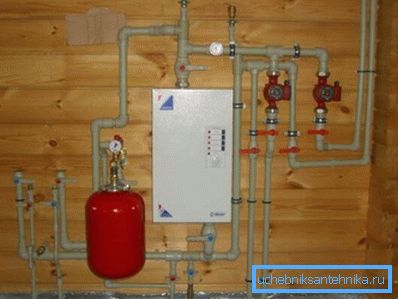
Positive qualities and disadvantages
In fact, this is a rather expensive way to heat buildings, because the price of electricity is relatively high. However, in terms of giving this option can be considered the most relevant, especially since heating is required only at certain intervals.
List of key benefits
- The low cost of the equipment makes it possible to arrange low-cost heating systems.
- When installing devices there is no need to contact specialized government agencies.
- Electric heating systems for the garden, unlike other analogues, are the safest.
- The efficiency of devices operating from the network is very high; therefore, with their help, you can organize the most efficient systems.
- During operation, the products do not create noise, which allows you to enjoy comfort.
- You can install the equipment directly with your own hands in order not to spend extra money.
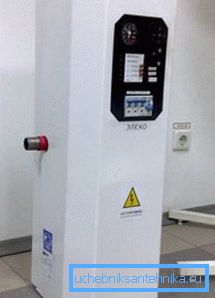
Addition! Another advantage is the compactness of electrical appliances for heating, which means that there is no need for them to allocate space. In addition, there is no need to create a hood.
Negative points
The very first reason that makes you stop using such heating systems is the high cost of electricity. However, it is realistic to save if you install the thermostats that can turn off the heating network at a certain temperature.
Another negative point is the ability to turn off the light, because with this option, the whole building will not be provided with heat. This problem is solved by installing a special generator that will turn on in case of emergency situations with power lines.
Main types of equipment
The main source of heat in such networks is the boiler, in which the coolant is heated to a certain temperature. Types of such devices may vary depending on the principle of operation.
To make it easier to navigate in the products, it is proposed to consider the main options.
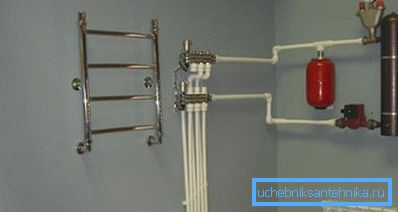
- Tubular devices assume the presence of a heating element made of metal, filled with a special insulator. In the central part there is a conductive thread transmitting the specific power directly to the surface.
- Induction boilers resemble a transformer in structure.. The primary circuit is the magnetic system, and the secondary is the heat exchange device. Due to this principle of operation, almost no scale is formed in the device.
- Electrode analogues act as devices of direct action, that is, when heated, there are no elements that are intermediaries. The current flows directly through the coolant. The temperature rises due to the chaotic movement of ions.

Note! Electric heaters for giving the latter type are the most economical, since the main function of the heating element is performed by the coolant itself.
Installation basics
Work on the installation of such equipment is simplified due to the lack of need for the installation of chimney channels. During the operation, there is no burning of any fuel, so oxygen is not absorbed in the room, which means that a powerful ventilation system is also not needed.
Choosing the right place
When electricity is provided to the dacha at home, it is allowed to locate a source of heat almost anywhere. However, the instrument must be easily accessible during maintenance and operation. A line with a rather high power should be connected to the installation site.

Wiring for the device
If the device is designed for 10 kW or more, then without a three-phase connection is unlikely to manage. You will have to purchase a product with less power or pay for connection to another type of power supply. The installation location of the domestic heating boiler from the meter should be suitable for wiring with the appropriate section.
Basic installation rules
For a particular model, a special manufacturer’s instruction is usually provided so that the installation can be carried out qualitatively.
However, there are general rules that must be followed when making the installation of electrical appliances for heating the coolant.
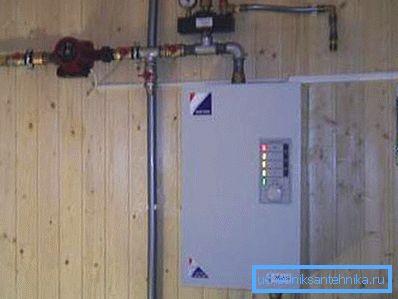
- On the one hand, space should be left to allow for maintenance.
- On the return pipe of the system must be installed on a mandatory coarse filter.
- On the supply cable you need to make a special switch, between contacts of which the distance will be more than 3 mm.
- Retaining walls and bases from the bottom must have sufficient strength to withstand the weight of the boiler.
Note! If in the course of work an electronic heating device is installed, then additional components need to be installed: pressure gauge, non-return valve and air vent.
Work
First, with the help of a building level and a pencil, marking is performed, that is, the boundaries of the device are determined. With the use of a drill, holes are made for dowels, if the wall is made of stone materials. To wooden surfaces of the product are fastened with screws alone.
Directly to the wall is fixed mounting plate and mounting profile. If the product is of the floor type, then a special metal stand is placed on the lower plane. After fixing the boiler, it is grounded, as individual models cannot function without it.
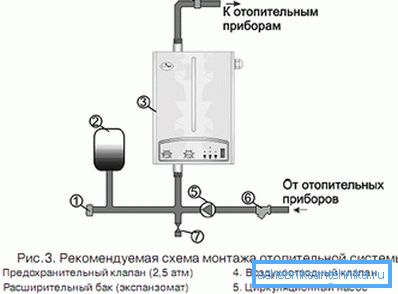
At the last stage, all sorts of sensors and accessories are installed. All wires suitable for them should be hidden in a special casing.
As a conclusion
From the above information we can conclude that electric heating for the dacha is a solution that is quite simple and affordable in terms of installation. With regard to efficiency in operation, with the right approach, costs can be minimized. The attached video will help in creating an efficient and reliable heating system.